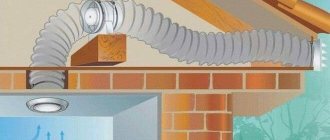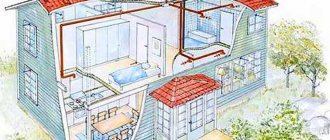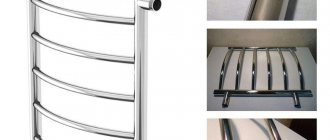In the absence of effective ventilation, dampness and unpleasant odors will settle in the bathroom and toilet, mirrors will fog up, and surfaces will become covered with mold. The cause may be a malfunction or blockage of the channel, deformation or partial demolition of its components, or the installation of fans. It is possible that the design cross-section is not enough to remove the steam that occurs when using plumbing fixtures with high water consumption. The vast majority of multi-storey buildings provide natural circulation with air flow through windows and exhaust through vertical shafts, from which communications are laid to each apartment. During a major overhaul, this system has to be created anew. During the work, it is necessary to take into account the direction of air flows in all rooms, as well as the specifics of the operation of a common house hood.
What is an exhaust fan and its purpose?
This device looks like a small device that, using blades on a shaft, moves air through the pipes of the ventilation system. At the same time, it does not affect the natural exhaust into the bathroom, provided that a check valve is installed in the supply pipe.
Purpose
An extractor hood product will be in demand in places where dampness, smoke or a specific odor accumulate. Because unfavorable aspects lead to rotting and the formation of fungus or the appearance of dark spots on the walls and ceiling. And in order to solve these problems in a timely manner, it is necessary to restore the purity of the air to a state in accordance with sanitary standards. It is in these situations that a ventilation device can solve the problem.
When is forced ventilation necessary?
Before purchasing and installing a fan in a bathroom or toilet, you need to make sure that forced ventilation is really needed there. You can understand that a regular hood is not enough by the following signs:
- The inflow and outflow of air from the premises is insufficient. It’s easy to check: open the door to the toilet or bathroom and place a sheet of paper on the ventilation grille. If there is sufficient ventilation, the sheet should stick to the grill.
USEFUL INFORMATION: How to lay tiles on a wooden floor in a bathroom
On some forums you can find advice to use a candle or a lit match when checking ventilation. In apartment buildings, it is undesirable to use this method: you can never be completely sure that there are no flammable or explosive gases in the air duct that have entered there from other apartments.
- There is a reverse draft effect - unpleasant odors from neighbors enter the room from the hood, which then spread throughout the home.
- Condensation accumulates on pipes and walls, and spots of mold or mildew appear.
In addition, forced ventilation is necessary if you plan to install a steam generator or electric sauna in the bathroom.
Types of exhaust fans
All devices for forced exhaust in the bathroom are divided into several types:
- By launch method. Without control and with control via sensors and remote control.
- At the installation site. Wall-mounted fans are often used for exhaust hoods; they can be easily removed if necessary, for preventive maintenance or replacement.
But there are also ceiling ventilation devices; they have many advantages:
- high productivity;
- easy installation;
- the ability to hide the fan housing behind a false ceiling;
- nice design.
Ventilating devices for exhaust hoods are also divided according to installation depth. There are overhead fans and those built into the wall at one level.
- By type of construction.
In order to understand which fan is best suited for bathroom and toilet hoods, you need to understand their structure.
There are four of them in total, but only two types are used in everyday life:
- Axial. The most popular model for use in bathrooms, since its installation is the easiest. The device is a cylinder, inside of which there is a motor with blades on a shaft. You just need to insert it into the ventilation shaft and secure it.
- Radial (centrifugal). It received this name because of the principle of its operation when air masses rush outward due to centrifugal force.
There are also channel devices. These ventilation devices are used for exhaust in hospitals, schools, kindergartens and other institutions.
Industrial installations are also used. As the name suggests, such fans are used in production workshops and factories.
Types of ventilation systems in the bathroom
To create air circulation in the rooms, natural and forced exhaust is created. In the first case, ventilation occurs due to the displacement of lighter, damp air by the cold air mass to the ceiling and then into the ventilation duct.
In the second case, sometimes not only fans are used for artificial circulation, but also air heaters, automatic control devices, etc.
Natural exhaust
Fresh air enters the bathroom through the cracks at the bottom of the entrance door or through a specially made opening. The exhaust channel is a vertical well for ventilation that goes outside. An exhaust hood in the toilet approaches it through a wall or a hole in the ceiling.
When installing a natural hood, the following requirements must be observed:
- The sanitary unit requires a separate air duct.
- It is allowed to combine ducts for bathroom and toilet exhaust only on one floor.
- When connecting to a ventilation shaft, a valve must be installed to avoid the creation of reverse draft and the appearance of specific odors.
In order to create the necessary exhaust hood, it is necessary to maintain the difference between the lower and upper points of the ventilation pipes. At the same time, for different temperatures, the replacement of air per hour will be different.
These data are shown in the table below:
| Pipe height in m | Air temperature in the bathroom | |||
| Consumption at 30˚С | Consumption at 24˚С | Consumption at 19˚С | Consumption at 15˚С | |
| 2 | 55,0 | 42,5 | 33,28 | 22,15 |
| 4 | 73,1 | 57,76 | 44,89 | 33,12 |
| 6 | 86,06 | 67,65 | 54,34 | 37,89 |
| 8 | 95,32 | 76,02 | 58,76 | 43,11 |
| 10 | 102,43 | 80,21 | 65,06 | 44,98 |
Flow rate is given in m³/h
Forced ventilation
The most effective today is supply and exhaust air circulation, technically provided by a heat recuperator. As a rule, it is used in those rooms where there is not enough natural exhaust - in the bathroom and toilet.
This mainly applies to rooms where a shower stall is installed, since the multiplicity there must be at least 75 m³/h. In addition, in the summer there is no significant difference between the temperatures inside and outside the bathroom, which is why the hood is significantly reduced.
To increase the inflow in such a room, an optimal gap under the door contributes, and the hood can be enhanced by means of a fan. There are many types of air circulation devices on the market, with different configurations, designs and performance. But they all have a similar operating principle.
After installing the ventilation device, it is necessary to check the effectiveness of its operation. This can be easily recognized with the help of a burning candle: you need to place the flame at the opening of the exhaust duct and if it deviates there, then the system is working normally.
Features of installation of natural ventilation devices
Having decided to get an outdoor toilet, you need to take care of its cleanliness. But this concerns not dust and dirt (the absence of which is also important), but the microclimatic conditions that exist in it.
It is most advisable to take care of ventilation not only of the cabin, but also of the cesspool. Therefore, you should start installing the ventilation system from the “underground”. To do this you need:
- Install a pipe in a vertical position in any corner of the rear wall of the restroom. One end of it should extend into the cesspool at a distance close to the maximum fill level of the tank. The second end is brought out to the roof.
- The outdoor section of the air duct from the pipe should protrude above the roof surface by at least 7 cm. The remainder should be cut off.
- Cover the air duct with a decorative cone (umbrella), which will protect the ventilation from precipitation. To enhance traction, experts also recommend installing a deflector with a weather vane function. Such a device in the toilet is a necessity, since there is no full flow of air into the tank.
We must not forget about the quality of the pipes themselves. It is necessary to select the highest quality material that is not susceptible to the influence of aggressive environments. The most affordable for domestic builders is plastic.
The most affordable pipes for domestic builders are made of plastic
An ordinary sewer pipe with a diameter of 11 centimeters or more can effectively remove methane from a reservoir using only simple physical laws.
After the ventilation of the cesspool is built, you can begin installing the devices of the room itself. For a country toilet, it is necessary to ensure high-quality air supply and exhaust. This is not difficult to do. On one of the side walls, it is necessary to drill a through hole with a diameter of 11 or more centimeters. The best place is 15 cm from the floor level.
Through this hole, clean air will enter the toilet. The second hole is an exhaust hole. It is placed on the opposite wall, but under the ceiling. Air ducts (pipes) are inserted into these holes. They should be placed vertically, at the street ends, covered with “umbrellas”.
Types of ventilation devices for premises
There are two types of devices used in bathrooms - products of axial and centrifugal design. The latest fans are also called radial fans. Axial mechanisms look like a shaft on which an impeller with blades bent at a certain angle is pressed. When the engine speeds up, the air flow through these blades is drawn into the pipe.
Centrifugal fans operate on a different principle. In them, a stream of air is first drawn into the center, and then enters the housing with the impeller. Due to the rotation of the blades, the air flow rushes to the sides and then moves through the exhaust passage into the ventilation shaft.
In everyday life, users find the greatest use of overhead devices, since they work more efficiently and with less noise. Centrifugal type devices are divided into basic and with built-in operations. The latest devices operate in an automatic cycle.
Selecting a ventilation device
When installing a hood in the bathroom, you will need to choose a suitable fan.
Let's look at the parameters you should pay attention to:
- First you need to find out its power, that is, how much air it can move through the system. Basically, this value depends on the diameter of the product.
- Fan diameter. This indicator will be discussed in more detail below.
- An important factor is the design of the device. Some manufacturers produce fans with a replaceable outer panel. Models Elicent, Electrolux, Ballu are available in different shades of color.
- A beautiful and fashionable device can be placed so that it will be the center of attention when entering the bathroom. Or, on the contrary, you can hide it behind the panel, and it will not be visible. The only condition that must be observed is to prevent it from coming into contact with external electrical wiring, because the device will have to be located in an area of high humidity.
- When choosing, pay attention to the noise level of the fan, since excess noise in the bathroom is annoying. The noise level that does not affect hearing should not exceed 25-27 dB.
You also need to pay attention to the warranty provided by the manufacturer. If its duration is less than 12 months, then it is better to refrain from purchasing this model.
Let's look at some of the fan's characteristics in more detail.
Power calculation
- First you need to calculate the volume of the room.
V= a × b × h, where:
a is the length of the room;
in – width;
h – height;
V is the volume of the room.
A. For example, a bathroom has dimensions: 1.5 – length; 1.5 – width; 2.8 – height. Find out the volume of the room by multiplying. It is equal to 1.5 × 1.5 × 2.8 = 6.3 m³. Round up to 6 m³.
- To calculate productivity, you need to multiply the volume of the room by the air exchange rate (this value is determined from the SNiP reference book). The number of air changes in a bathroom is 6-8 times, for a toilet this figure is 8-10 times. The specific number is selected depending on the number of family members who have benefited from the treatments in these rooms.
- Accordingly, from the table we select the required air exchange rate, for example, take the indicator 8 for the bathroom. Multiply 6 m³ × 8 = 48 m³/h. In other words, 48 m³ of air must be replaced in one hour.
Based on the calculations obtained, you need to select the appropriate fan for the bathroom. This usually adds up to 30% of the total performance of the device.
Device diameter
Nowadays on the ventilation equipment market you can find products with different air duct cross-sections. Classic sizes include: 100, 105, 125, 160 mm and others. The diameter of such devices must be selected, first of all, based on the size of the ventilation shaft opening.
Secondly, on the required parameters of the product. For example, the power of the exhaust device will significantly depend on the diameter of the blades. Obviously, the larger the diameter, the greater the productivity of the device.
In houses built in the 60s and 70s, the apartments are relatively small, and the best option there would be a diameter of 105 mm. In new buildings of recent decades, apartments are rented with a larger area; in this case, it is recommended to choose 125 or 160 mm.
Choosing the right fan for the toilet
In typical city apartments, a vertical ventilation duct is usually installed, for which the best option is a centrifugal fan.
A duct ventilation device will show worse results. Such fans are best used when combining several ventilation channels or in cases where there is a need to hide the device in a suspended ceiling structure.
USEFUL INFORMATION: Design of a toilet in an apartment: choosing the finish - tiles, wallpaper, paint, PVC panels (45 photos)
Installing an axial fan only makes sense with short horizontal ducts.
We recommend paying attention to fan models equipped with additional options (a separate power supply line will be required):
- With check valve. Due to its design features, such a fan will not allow air from the shaft back into the room. Residents of apartment buildings will appreciate its advantage due to the fact that they will no longer be forced to inhale odors coming through the ventilation from neighboring apartments.
- With motion sensor. The device will turn on when a person enters the toilet, and when he leaves, the fan turns off.
- With timer. A specific program is set to ensure continuous operation of the fan for 2–30 minutes.
- With humidity sensor. Automatically turns on the device when the humidity in the room reaches a certain level.
- With ventilation mode. The fan does not stop operating, but operates at minimum speed.
DIY hood installation
Before making a hood in the bathroom, you need to make the appropriate preparatory measures:
- First, you need to check the draft in the ventilation shaft by holding a lit candle or match near the hole. If the flame deviates towards the well, this means that the hood is working naturally. If the flame deviates back, it will be necessary to clean the vent. channel. If you suspect that the channel is tightly clogged, you need to call specialists. They will check the entire well from the roof of the house and fix the problem.
- Try on the purchased device. If the device does not fit into the ventilation hole, you can expand it, or exchange it in the store for another more suitable model.
- Remove the outer mesh and grid from the device.
It is also important to check the air flow into the room with the doors to the bathroom closed. You may have to install a special grille at the bottom of the door leaf or trim the door by removing it from its hinges to leave a larger gap at the bottom. These options will make the flow from the living room to the bathroom constant.
Hole preparation
If the hole does not match, and it was not possible to change the fan, then this can be corrected as follows. When the hole in the channel is larger than the cross-section of the device, then you need to insert a plastic or corrugated pipe into the hole and seal it with foam around the gap. And after it has cooled, cut off the protruding fragments of the filler with a sharp knife.
If the hole in the exhaust shaft is smaller than the diameter of the exhaust product, it must be expanded using a hammer drill and a bolt. To do this, you need to drill holes along the intended circumference, and then use a jumper to chop off the jumpers.
Selecting the optimal connection scheme
There are several methods for connecting ventilation to the power line. The fan can be turned on by configured sensors, or by turning on a light bulb in the bathroom. In the first case, it turns on after the humidity in the room reaches the maximum value.
The end of operation of the device can also occur in two ways: by a timer after a certain time or by a switch located in the bathroom.
Connecting the hood to the light bulb ensures that it starts working the moment the light is turned on. However, the device needs an individual switch so that these two chains can be disconnected: the hood and the lighting. It is usually installed on the wall, if it is not intended to be placed on the product body itself.
In the latter case, the fan is turned off by pulling the chain. If possible, choose a model with a long cord so that it is accessible to small family members.
Timer shutdown has its pros and cons. When leaving the bathroom, you don't have to worry about turning off the device. But if the fan does not completely remove dampness, and it is necessary to increase the time, then inconvenience arises. Therefore, it is better to purchase a product with a switch so that its operation can be controlled.
The procedure for carrying out installation work
Before installing the fan, you should carefully read the instructions. Remove all accessories from the box: fasteners in the form of four dowels and screws. If you don’t have the opportunity or desire to drill, you can glue the device’s mounting location to the wall. But if you have to change it, it will be difficult to remove the fan.
Let's take a closer look at the entire algorithm for installing a fan on an exhaust hood in a bathroom using self-tapping screws:
- remove the facing grille from the device by unscrewing the bolt or removing the latch (depending on the model);
- insert the product body into the hole in the exhaust well;
- make markings for the mounting holes, taking into account the location of the cable entry;
- remove the device from the hole;
- drill holes for dowels in the marked places (if you have to do this on tiles, you need to drill with care so as not to split them);
- insert plastic rods into the drilled holes;
- insert the wire into the technological window, align the holes with the dowels and secure the fan;
- open the terminal box and install the wires according to the diagram;
- lay the wires in special channels, close the box;
- check the operation of the device, turning on the light or from your switch.
Thus, the forced ventilation in the bathroom is set up and ready to remove damp air from the bathroom.











